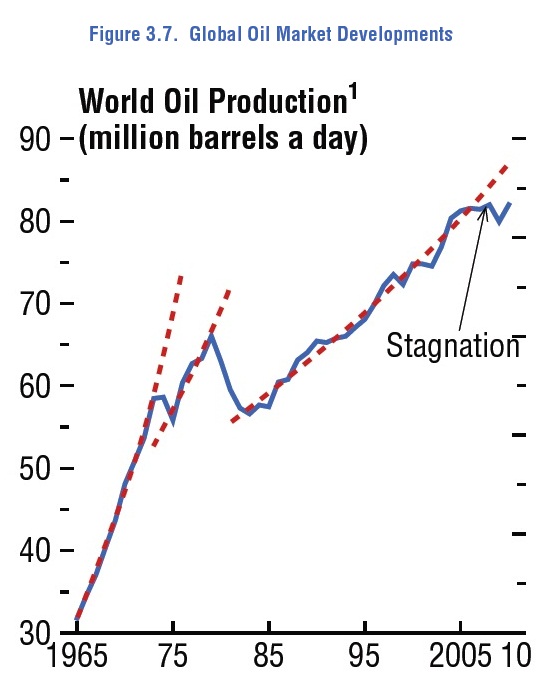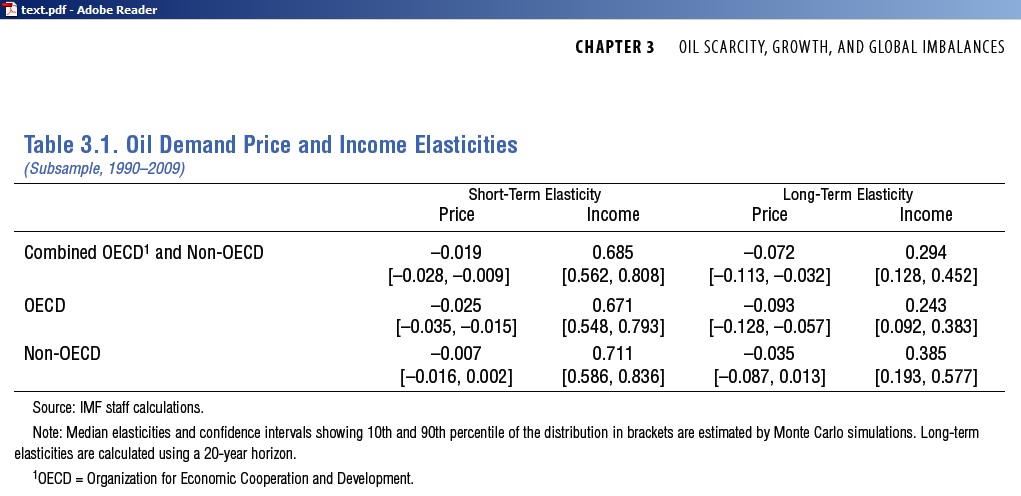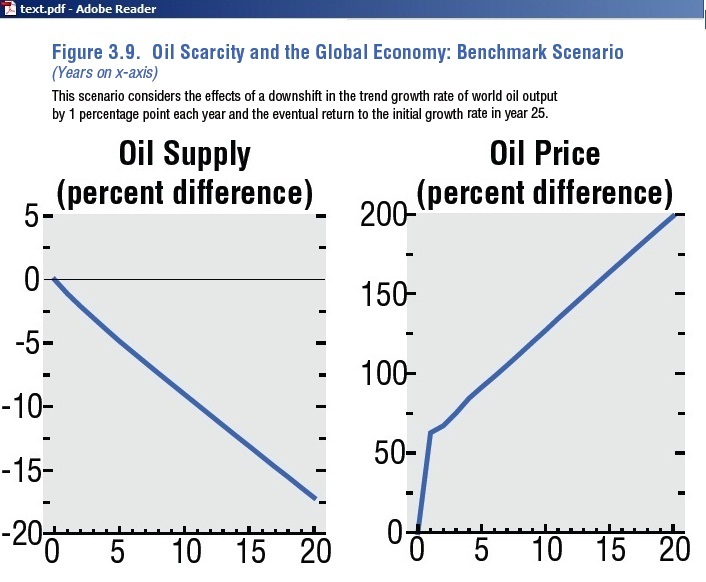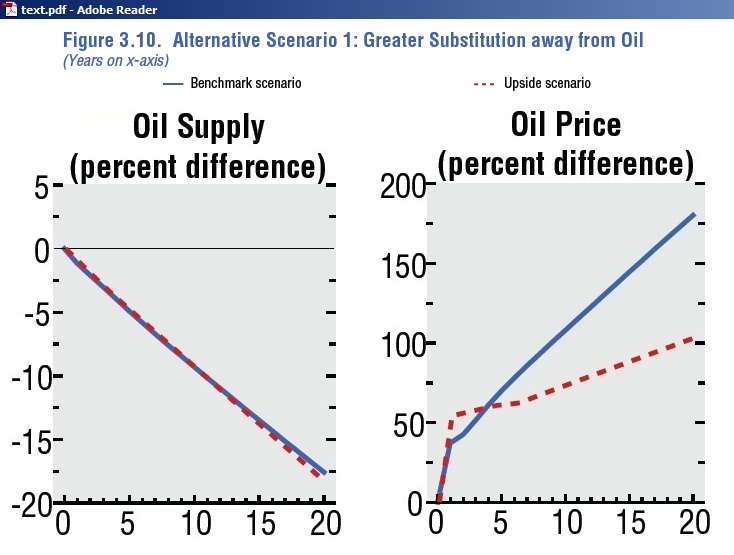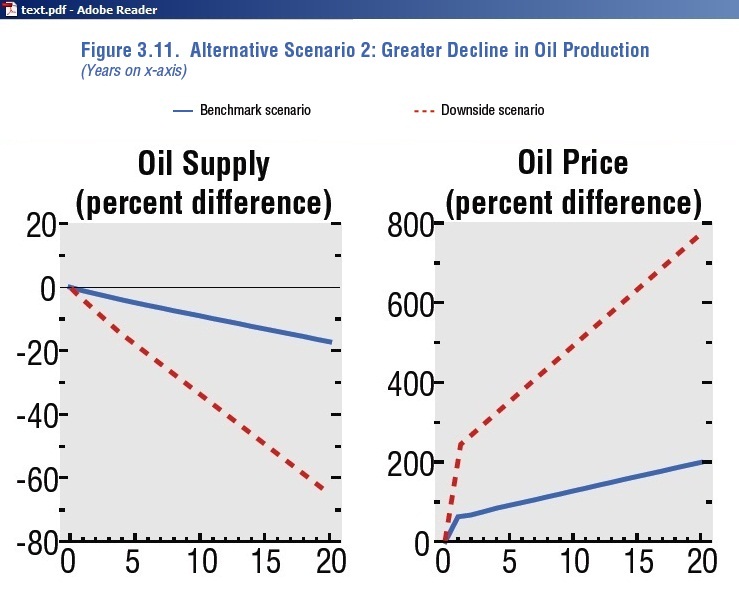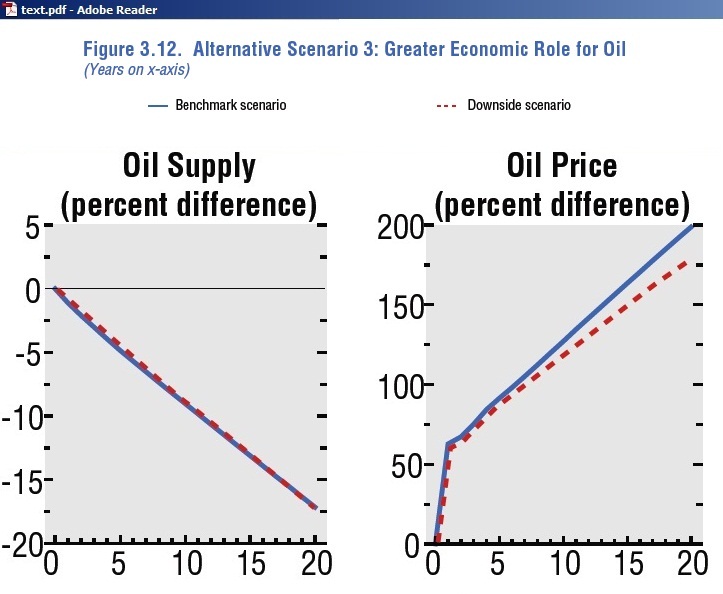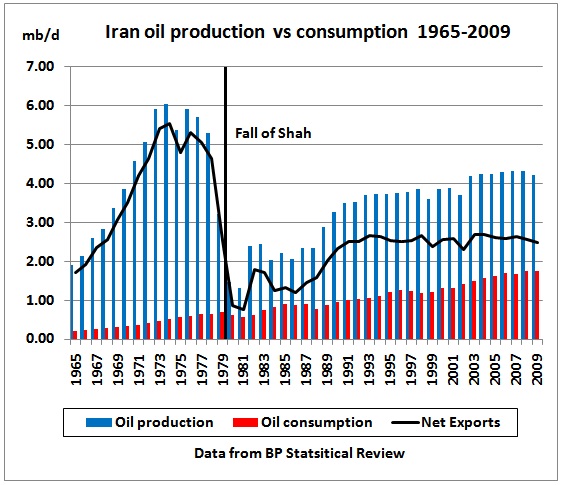In a benchmark scenario of its latest World Economic Outlook (April 2011) the International Monetary Fund (IMF) analyses what it calls oil scarcity (after “energy security” another code word for peak oil?) and warns of a 60% increase in oil prices within a year and almost 90% within 5 years due to a reduced growth in global oil supplies (assumed to be + 0.8% pa, down from a long term 1.8%) and low oil price elasticities of oil demand between 0.02 (short-term) and 0.08 (long term). Even in the best case scenario in which oil price elasticities increase almost 5 fold (greater substitution away from oil), oil prices are simulated to go up by 60% in 5 years.
| Summary table of scenario simulation | |||
| Scenario | Input parameter | Oil price increase | GDP |
| BenchmarkFig 3.9 | Oil supply growth down to 0.8% pa | Immediate spike of 60%,200% in 20 years | – 3% |
| Scenario 1Fig 3.10 | Oil price elasticity of demand 0.3 | Immediate increase of 50%, but “only” 100% in 20 years | – 1% |
| Scenario 2Fig 3.11 | Oil supply decline -2% pa | Immediate increase of 200%. In 20 years 800% increase but non-linear impact not covered by model | – 10% |
| Scenario 3Fig 3.12 | Contribution of oil in output 25% instead of 5% | Long-term reduction of oil price increase by 25% | – 6% |
The IMF report can be found here:
http://www.imf.org/external/pubs/ft/weo/2011/01/pdf/text.pdf
All graphs in this article are from chapter 3 “Oil scarcity, growth and global imbalances”
(I) Oil supply context and outlook until 2015
Starting point for the IMF is the observed change in the 1.8 % oil supply growth trend from 1983 which ended in 2005.
The outlook for the next years has been taken from the Medium Term Oil Market Report of the IEA:
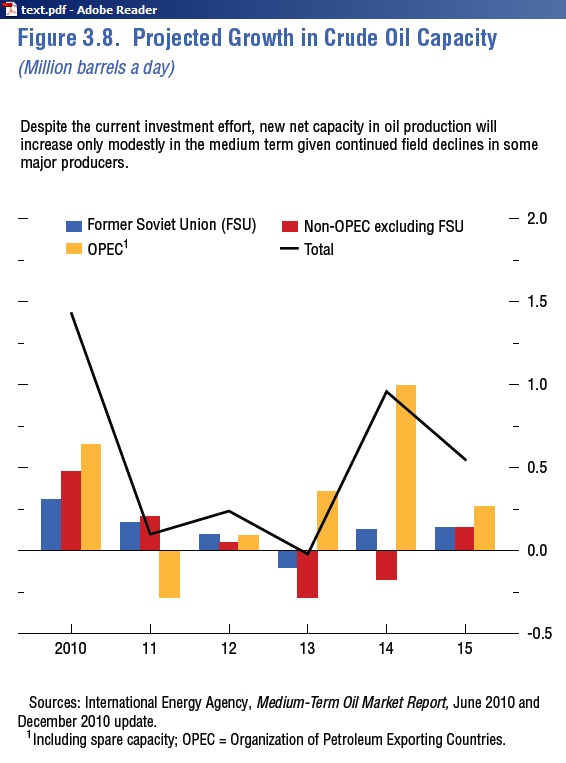 The graph shows negligible net additions in years 2011 to 2013. OPEC’s incremental barrels in 2013/14 are supposed to come from the Saudi oil field Manifa, heavy-sour crude for which a special refinery is under construction.
The graph shows negligible net additions in years 2011 to 2013. OPEC’s incremental barrels in 2013/14 are supposed to come from the Saudi oil field Manifa, heavy-sour crude for which a special refinery is under construction.
Aramco Manifa oil field will start in 2013, chief says
9/12/2010
Saudi Arabia’s Manifa oil field is on schedule to start pumping 500,000 barrels a day in 2013 and Saudi Aramco is planning chemical and refinery plants to process the kingdom’s crude, the company’s chief executive officer said.
“It’s planned ultimately for 900,000 barrels per day but the market doesn’t need 900,000 barrels now,” Khalid Al-Falih said today in Dubai. Manifa had been slated for completion next year before oil demand slumped amid the global recession.
No need for 900 Kb/d? That tells you everything about future OPEC capacities
(II) Oil demand price and income elasticities
With trend changes in oil supplies and oil prices in mind the IMF analyses the oil demand price and income elasticities of the past, both short term and long term (past 20 years):
(III) How to calculate oil price increases in a period of oil scarcity
On the basis of the above, the IMF assumes for the next 5 years (p 99,100)
(a) Because capacity increases are the main drivers of supply growth—the short-term price elasticity of supply is very low, with most estimates ranging between 0.01 and 0.1—supply increases will likely be equally modest, except for the buffer provided by OPEC spare capacity. The latter is currently estimated at some 6 million barrels a day. Assuming that between two-thirds and four-fifths of that spare capacity will eventually be tapped, cumulative oil supply growth during 2011–15 could amount to 6 to 8 percent, or 1¼ to 1½ percent annually on average, if the price of oil remains broadly constant in real terms.
(b) The current WEO forecast is for an annual average world GDP growth rate of about 4.6 percent over the period 2011–15.
and calculates as follows:
(1) GDP growth x income elasticity = 4.6 % x 0.68 (table 3.1) = 3 % oil demand growth
(2) Gap between oil demand growth and supply growth 3 % – 1.5% = 1.5 % pa gap
(3) Oil price increase = % gap / demand price elasticity = 1.5% / 0.02 (Table 3.1) = 75%
That of course is shocking. In order to come out of this catch 22 between GDP growth and limited oil supply growth the IMF then embarks on simulating 4 scenarios, whereby oil is used as a 3rd parameter (apart from capital and labour) in the economy’s production functions.
General assumptions in modelling:
- Oil price elasticity of oil demand in both production and consumption: 0.08 (long term) and 0.02 (short term)
- Oil cost share in production: 2-5%
- Oil supply growth below historical trends
- Oil supply response with a low price elasticity of 0.03
- Initially, 40% of oil revenue to be used for intermediate goods inputs, later real extraction cost will increase at a constant 2%
- In oil exporting countries governments will not spend oil receipts immediately but accumulate them in US dollar and use them at 3% pa
- Short term oil shocks (impact on financial markets, confidence effects) are NOT included
(IV) Benchmark scenario
Assumption:
- Average oil supply growth rate of 1.8% is reduced by 1% to 0.8 % pa
Result of benchmark simulation:
- Immediate oil price spike of 60%
- 200% oil price increase over 20 years
- Reduction of GDP in oil importing countries, but surge in goods exports to oil exporters
- Wealth transfer from oil importers to oil exporters, whose currencies appreciate
- Reduction in real interest rates as the oil exporter’s additional oil revenue leads to higher savings
- Emerging Asia benefits from lower world interest rates for their investments
- US and Euro current accounts deteriorate
(V) Scenario 1: greater substitution away from oil
Assumptions:
- Higher, optimistic long term oil price elasticity of demand is 0.3
Result of scenario 1 simulation (dotted red line):
- World oil prices increasing by only 100 % (instead of 200%) in 20 years
- Fall in GDP reduced by 2/3
The IMF concludes: “This simulation highlights the fact that fairly high demand elasticities would be required to negate the effects of lower oil availability” .(p 104)
(VI) Scenario 2: greater declines in oil production
The IMF may be very well aware that the assumed 6 mb/d OPEC spare capacity may not actually exist. This could be the reason why this oil decline scenario is done.
Assumptions:
- The oil supply growth rate is reduced by 3.8% (instead if 1% in the benchmark), leading to a decline of -2% pa (=1.8 % trend – 3.8 = – 2%)
Results of simulation:
- 200% immediate increase in oil price and 800% over 20 years
- Long-term output and current account effects are 3-4 times as large as in the benchmark
- Changes of this magnitude may have non-linear effects which the model does not handle
(VII) Scenario 3: greater economic role of oil
This scenario considers research from economists indicating that certain technologies are possible and remain usable only when there is a ready supply of oil.
Assumptions:
- The contribution of oil to output is increased from 5% to 25% in the tradables sector and from 2% to 20% in the nontradables sector
Results of simulation:
- Deterioration of GDP by factor of 2
(VIII) IMF’s summary and conclusion
“The alternative scenarios indicate that the extent to which oil scarcity will constrain global economic development depends critically on a small number of key factors. If, as in the benchmark scenario, the trend growth rate of oil output declined only modestly, world output would eventually suffer but the effect might not be dramatic. If higher oil prices brought about easier substitution away from oil, not just temporarily but over a prolonged period, the effects could be even less severe. But if the reductions in oil output were in line with the more pessimistic studies of peak oil proponents or if the contribution of oil to output proved much larger than its cost share, the effects could be dramatic, suggesting a need for urgent policy action. In the longer term, the worst effects would be experienced by regions whose production is highly oil intensive, such as emerging Asia, and/or with weak export links to oil exporters, such as the United States.” (p 106/7)
This rather optimistic summary comes along with a number of conditions which must be met for the model to work:
- In general the transition to a new equilibrium in the balance between oil supply and demand must be smooth
- Financial markets absorb the huge flood of petro-dollars
- Business responds flexibly to higher oil prices and re-allocates resources accordingly
- Lower real wages do not spark social unrest
The IMF is fully aware of the limitations of their model and that it could be too optimistic:
- “Unlike in the model, real economies have many and highly interdependent industries. Several industries, including car manufacturing, airlines, trucking, long-distance trade, and tourism, would be affected by an oil shock much earlier and much more seriously than others. The adverse effects of large-scale bankruptcies in such industries could spread to the rest of the economy, either through corporate balance sheets (intercompany credit, interdependence of industries such as construction and tourism) or through bank balance sheets (lack of credit after loan losses).
- Finally, the simulations do not consider the possibility that some oil exporters might reserve an increasing share of their stagnating or decreasing oil output for domestic use, for example through fuel subsidies, in order to support energy-intensive industries (for example, petrochemicals) and also to forestall domestic unrest. If this were to happen, the amount of oil available to oil importers could shrink much faster than world oil output, with obvious negative consequences for growth in those regions” (p 109)
- Such benign effects on output [-0.25% in GDP], however, should not be taken for granted. Important downside risks to oil investment and capacity growth, both above and below the ground, imply that oil scarcity could be more severe.
- Moreover, unexpected increases in oil scarcity and resource scarcity more broadly might not materialize as small, gradual changes but as larger, discrete changes. In practice, it will be difficult to draw a sharp distinction between unexpected changes in oil scarcity and more traditional temporary oil supply shocks, especially in the short term when many of the effects on the global economy will be similar.
- In addition, it is uncertain whether the world economy can really adjust as smoothly as the model envisages. Finally, there are risks related to the scope for the substitution away from oil, on both the upside and the downside. The adverse effects could be larger, especially if the availability of oil affects economy-wide productivity, for example by making some current production technologies redundant. (p 110)
Most of the above points have been discussed by peak oil aware analysts for years. It is a big step forward that the IMF has now brought this to the attention of the financial community who will hopefully be able to read between the lines and separate optimistic outlooks from reality.
(IX) Policy implications
The IMF advises, in very diplomatic language and on a macro-economic and structural level:
“Fundamentally, there are two broad areas for action. First, given the potential for unexpected increases in the scarcity of oil and other resources, policymakers should review whether current policy frameworks facilitate adjustment to unexpected changes in oil scarcity. Second, consideration should be given to policies aimed at lowering the risk of oil scarcity, including through the development of sustainable alternative sources of energy.” (p 110)
But this is more interesting:
“Regarding policies aimed at lowering the worstcase risks of oil scarcity, a widely debated issue is whether to preemptively reduce oil consumption— through taxes or support for the development and deployment of new, oil-saving technologies—and to foster alternative sources of energy. Proponents argue that such interventions, if well engineered, would smoothly reduce oil demand, rebalancing tensions between demand and supply, and thus would reduce the risk of worst-case scarcity itself.”
(X) Comments:
– The 6 mb/d spare capacity assumed in the introductory calculation is not there, as shown in the case of Saudi Arabia in this post:
2/3/2011
WikiLeaks cable from Riyadh implied Saudis could pump only 9.8 mb/d in 2011
http://www.crudeoilpeak.com/?p=2669
– The model does not consider the impact of peaking and then declining oil production in major oil producing countries. For example, in the above graph of the world’s oil production history we see the oil crises in 1973 and 1979. The OPEC embargo after the Yom Kippur war was only successful AFTER the peaking of the US production in 1970. And that was the non-linear impact:
German highway patrol stopping motorists to check their driving permits (trips deemed “essential”)
during Sunday driving bans in November 1973 on an otherwise empty autobahn
http://www.abendblatt.de/multimedia/archive/00158/konjunktur4_HA_Wirt_158883b.jpg
And the Iranian revolution was preceded by the peaking of Iranian oil production BEFORE the fall of the Shah.
– Oil price movements will not follow straight lines but will zigzag around trend lines as we have already experienced in the last years
– The panels in Figs 3.9 – 3.12 do not show inflation and employment. Due to higher oil prices inflation is going to increase, especially in oil importing countries.
– It is not clear why oil supplies should increase again after 25 years – as mentioned in figure 3.9
– It is also not clear to which oil price level the increases relate to: is it $100 oil?
– The focus should be on the first 5 years in those scenarios which is a reasonable time during which many implied parameters in the models may still be valid. We really do not know how the world will look like in 10 years, not to mention 20 years.
– The above scenarios show that the lowest oil price increase and the smallest negative impact on GDP can be achieved by increasing the oil price elasticity of demand. This means:
(1) Any project which increases oil demand like toll-ways, new airports, new car dependent sub divisions and shopping centres will NOT be increasing this elasticity and thus contribute to a lower GDP than would otherwise be the case.These projects should be immediately abandoned.
(2) Given the short time during which oil prices are estimated to explode the only way to increase price elasticity for petrol is car pooling. This in turn means the financial end for toll-ways – unless tolls are charged per passenger and not by car. Past peak oil ignorance has trapped us now.
(3) There is no more time to transition the car fleet before big oil price increases make current long distance commuting by car unaffordable.
(4) All new infrastructure projects must be designed to lower the demand for oil, fast and at the lowest possible construction cost. That can only be achieved by electric trolley buses & light rail in urban areas, night trains between capital cities and rail freight
Conclusion: The IMF’s World Economic Outlook gives us a glimpse into the future of run-away oil prices and the short time frame during which these prices will reach unaffordable levels. While the IMF’s summary at the beginning of the oil scarcity chapter suggests that the oil supply outlook poses no “major constraint” on global growth, details in all scenarios presented demonstrate that dramatic changes are ahead of us
